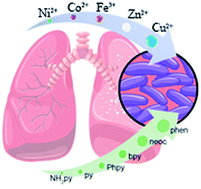What are the prospects for using complexes of copper(ii) and zinc(ii) to suppress the vital activity of Mycolicibacterium smegmatis?†
Abstract
New complexes of zinc(II) and copper(II) with 2-furoic acid (Hfur), acetic acids and N-donor ligands with the compositions [Zn2(fur)4]n (1), [Zn2(fur)4(NH2py)2] (2, NH2py = 3-aminopyridine), [Zn(fur)2(neoc)] (3, neoc = 2,9-dimethyl-1,10-phenantroline), [Zn(OAc)2(neoc)] (4, OAc = acetat-anion), and [Cu(fur)2(neoc)(H2O)] (5) were synthesized. The structures of the compounds were established by single crystal X-ray diffraction analysis. Complexes 1 and 2 are binuclear; whereas 3–5 are mononuclear. The stabilization of supramolecular architectures in crystals for compounds 1–5 occurs due to π–π-bonding between heterocycles and hydrogen interactions that provide good solubility in aqueous solutions. The stability of the complexes upon dissolution in 5% dextrose and 0.9% NaCl was confirmed by UV-vis spectroscopic and NMR (1H) data. The study of in vitro biological activity was carried out against the non-pathogenic strain of Mycolicibacterium smegmatis that is a model for M. tuberculosis. The synergistic effect of ligands is observed for complexes 3–5 and is characterized by an increase in the biological activity values. On passage from Zn2+ to Cu2+ complexes, the biological activity increases and the maximum effect is observed for compound [Cu(fur)2(phen)]. Analysis of the transcriptomic profiles of the M. smegmatis mc2 155 strain under the pressure of the copper complex [Cu(fur)2(phen)] made it possible to isolate 185 genes, one quarter of which are associated with the compensation of iron deficiency in the bacterial strain. Genes associated with the transport and metabolism of heavy metals, biosynthesis of fatty and amino acids, biodegradation and transport of urea were also isolated.



 Please wait while we load your content...
Please wait while we load your content...